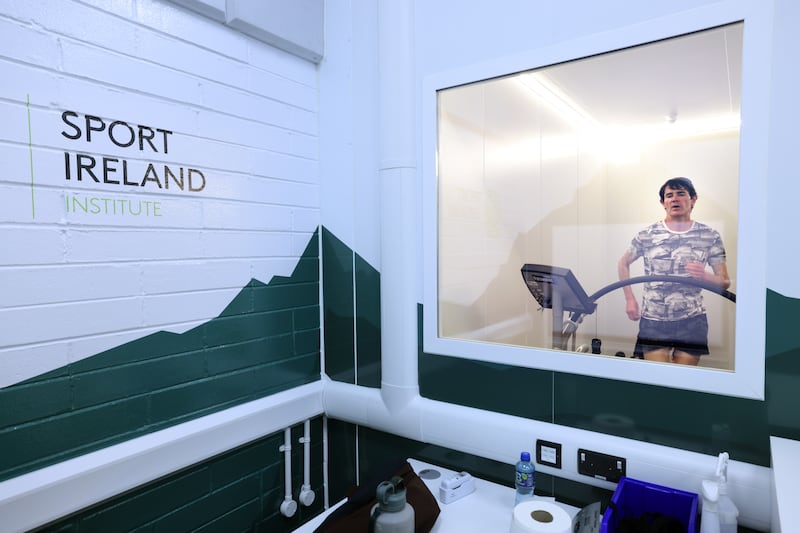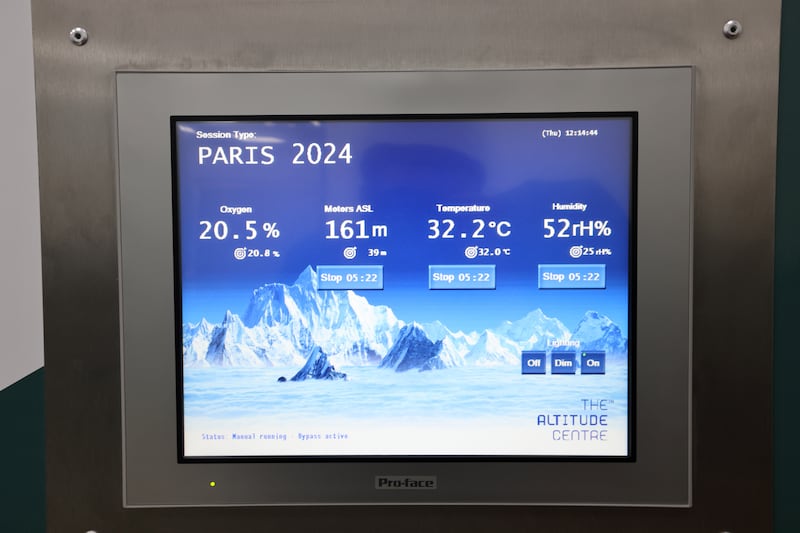It starts with a soft watering of the eyes and then a dripping off the nose. Then very quickly it comes on like buckets of rain. Then buckets of tears. And just like that you’re drenched to the bone with sweat, and crying “enough”. And possibly swearing just a little.
It’s been a long time since this once temple of a body ran itself to anywhere near exhaustion in any sort of proper heat and humidity. But this is purely for research purposes, to get some idea of the conditions Irish athletes can expect at the Paris Olympics in July. Or actually a perfectly accurate one – all done with the press of a button and the flick of a switch and the sealing of a chamber door.
It’s Thursday lunchtime at the Sport Ireland Institute in Abbotstown, and the opening of its new training chamber which can simulate any environment on planet Earth – from extreme desert heat to freezing high mountains. Just tap in your desired temperature, altitude and humidity and off you go.
For my test run it’s naturally set for Paris and the average daily conditions come July, which means it’s currently reading 32.5 degrees, 54 per cent humidity, at the city altitude of 161m. It can go as high as 5,000m (which is Everest base camp), up to 90 per cent humidity, and any temperature between -20 and +50 degrees – but that’s for someone else on another day.
The agonising story of how two Irish sailors lost out on an Olympic medal
Sonia O’Sullivan: A home victory would be worth so much more to the Dublin Marathon than course records
Daniel Wiffen finds inspiration from Joyce on the next stage of his swimming odyssey
After the Olympics, athletes face a further tough challenge: the comedown

Inside are two treadmills and three stationary bikes, and once that chamber door is sealed, how long the athlete wants to or can last inside is entirely optional. The purpose is to gradually work on the acclimatisation process, and gain as much familiarity with the conditions as possible before they step out on to the track, field or whatever is their Olympic arena in Paris.
After wintering in the occasionally arctic conditions of the Dublin Mountains, my plan is to run for 30 minutes, easing up to 16km/h on the treadmill while staring out the window in front of me, pretending it’s just a morning run down along the Seine.
I also have a pair of Nike Alphafly 3 on my feet, a perfectly legal advantage. And great care was taken to be fully hydrated, preparing from a full half day in advance. It hardly matters. Once those doors of perspiration are opened there is no stopping them, and with the first blistering of heels and worrying loss of breath after 15 minutes, my time is up. Run to a standstill.

That wouldn’t even be a warm-up for Eliud Kipchoge before he runs the Olympic marathon in Paris, seeking a record third successive title; and this, remember, is just an average daily temperature for July. The temperatures could go higher, and naturally that goes for spectators too.
At a cost of €680,000 the climate chamber is not necessarily cheap, but there is a significant and lasting return on that investment – affording all athletes at the Sport Ireland Institute the opportunity to acclimatise to whatever conditions they might be competing in next, while also cutting down on their carbon footprint by removing the need to travel to faraway places to seek those same conditions.
Those cover heat or cold, the chamber equally beneficial to athletes preparing for a Winter Olympics, or any extreme event.

It’s been in use for several weeks already for athletes preparing for Paris. Last month, Paul O’Donovan paid a visit before the European Rowing Championships, setting up his ergometer rowing machine in the chamber, and lasting one hour and 30 minutes. Non-stop. (Afterwards, they mopped up four full buckets worth of sweat off the floor. Maybe even some tears too.)
The adjacent room is also set to Paris summertime temperature on a permanent basis, so athletes can hang out for the afternoon or evening and pretend they’re somewhere down along the Seine.
Zac Ward, a member of the Irish Rugby Sevens who will be in action in Paris, has also been a regular user in recent weeks.
“We fully expect it to get really, really hot in Paris,” he says. “So it’s definitely making a big difference to our preparations. We play in mostly hot conditions anyway. With heat, you can get used to things a bit quicker, but with high humidity, it’s much harder, trying to get the oxygen in. We’re not used to that at all.
“Some teams are always more used to hot conditions, which is an advantage to them, so this makes it a bit more of a level playing field, lets us hit the ground running. Before we might take a day to acclimatise, but now, after using the chamber here, we can wake up the day after we land and hit the pitch straight away.”
My experience of running in a virtual Paris in July left me thinking about Noel Carroll, co-founder of the Dublin Marathon, who always said it’s not the distance that kills, it’s the pace. In Paris, you can add the temperature to that equation.





